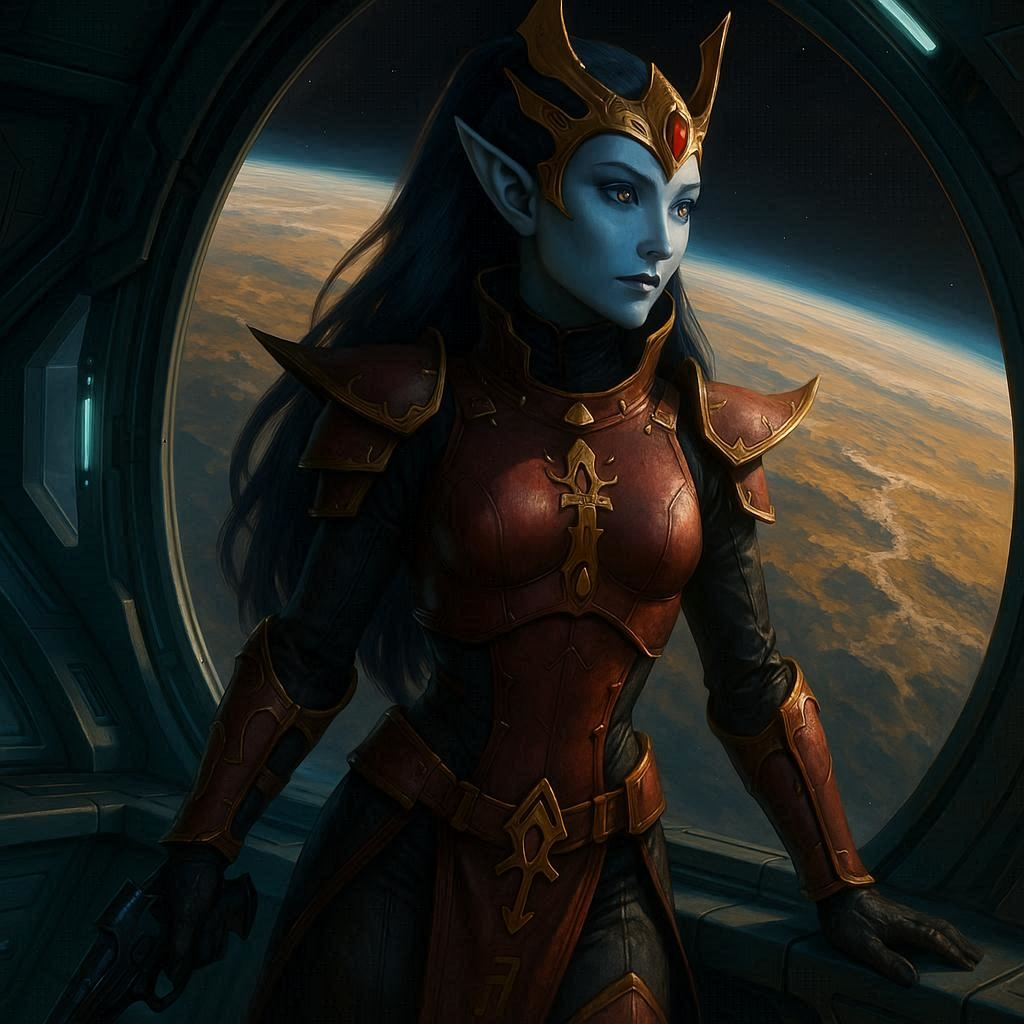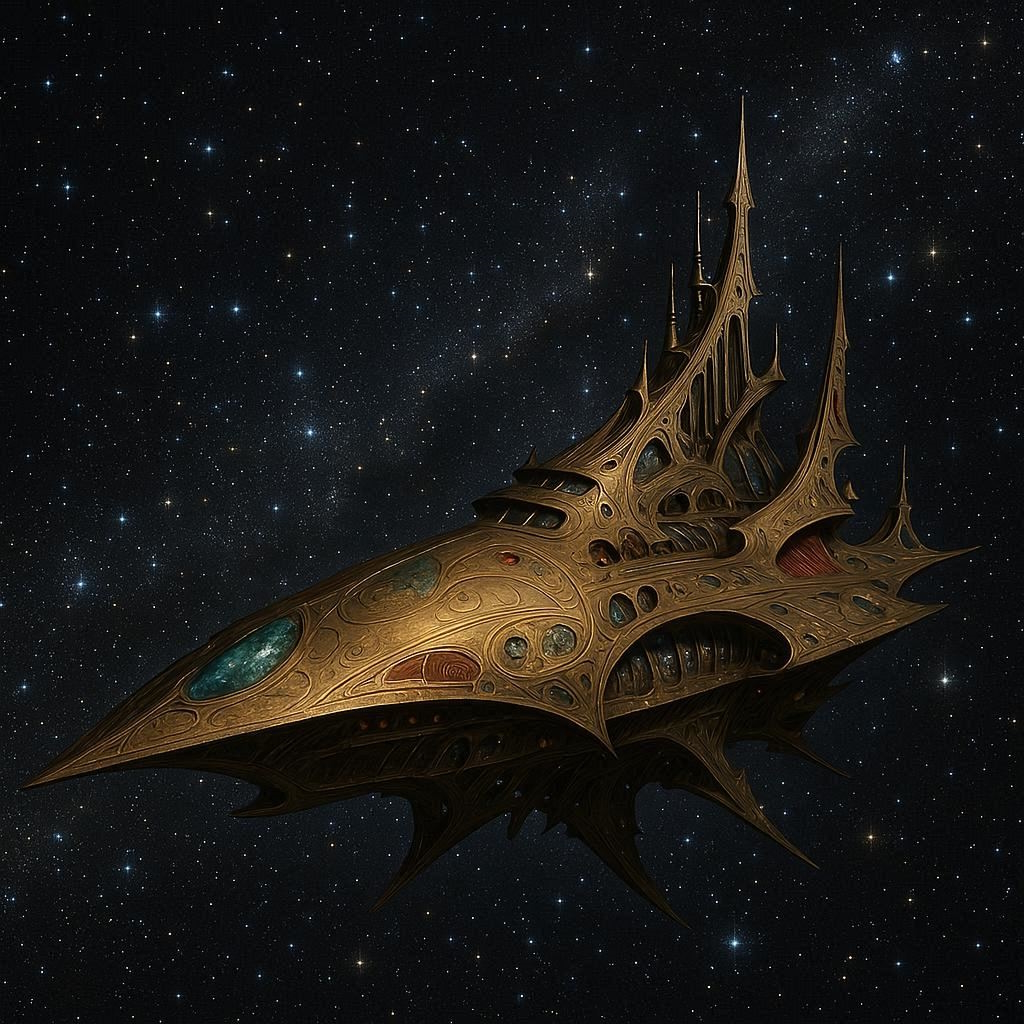The Aeldari – Ancient And Dying Race

Once lords of the stars, the Aeldari—known to some as Eldar—now drift like echoes of a forgotten golden age. Their story is not just of tragedy, but of survival, beauty, and the fragility of power.
Fans of the Warhammer 40k universe sometimes called the Eldar Space Elves. Their forms are lithe and elegant, echoing humanity but refined by eons of psychic evolution. Their blood flows quicker, their minds dance faster, and their hearts beat to rhythms few could follow. To watch an Aeldari move is to glimpse a symphony in motion. Thanks to their well developed psychic abilities, which also serves as a foundation for Eldar technology, the life of an ordinary eldar can last for a thousand years. However, some of them can extend their lifespan up to ten thousand years and beyond.
The Eldar empire was basically the stuff of legends—technologically advanced, culturally rich, and let’s not forget, they wielded psychic powers like nobody’s business. They were literally living the dream. And like many empires before it, this empire also remains just in memories of the universe.
Sure, the Aeldari faded from their once-mighty position, but their influence still echoes across the galaxy. They might be a shadow of their former selves, yet their presence, smart strategies, and resilience make them a force you can’t ignore. Whether you’re just curious about sci-fi lore or seeking lessons in resilience, the Aeldari story offers plenty to ponder over.
Echoes Before the Silence
In the beginning, there was no Empire, no tragedy, no name whispered with reverence or regret. There was only song.
The Aeldari were born not into war, but into wonder. Before the rise of humanity, before even the first breath of many younger species, they wandered the stars in harmony with both the material and immaterial worlds. They did not build in the way others did—with crude tools and brute force. Theirs was a creation of will and art, of thought and rhythm. Their ships sailed not only through realspace but through the shimmering corridors of the Webway, each one a masterpiece, each one an echo of their brilliance.
They were not perfect, but they were whole.
Each Aeldari bore the fire of psychic potential. Not raw, uncontrolled like that of many humans, but refined, honed across generations. It connected them—not only to each other but to the very fabric of the universe. Their cities sang. Their blades whispered. Their minds touched stars.
And yet, beneath it all, something stirred. A dissonance. A hunger.
In those golden days, the Aeldari believed themselves eternal. With no equal in technology, spirit, or beauty, they turned inward—not to contemplation, but to indulgence. What began as art deepened into obsession. What was once joy became hedonism. And slowly, without realizing, they began to shape something in the Warp. A reflection of their darkest desires. A child of their own excess.
But in those early days, no one saw it.
They only heard the music.
The Birth of Silence
The change did not come all at once. It never does. Like a great tide turning beneath still waters, it began slowly—unseen, unspoken, but always there.
The Aeldari did not notice it at first. Why would they? Their worlds still shimmered with beauty. Their fleets still glided through the stars like living dreams. Their minds still touched one another in perfect song. But the melody had changed. Some notes grew sharp. Others vanished entirely. The harmony became harder to hold.
Among the seers, a few began to feel it: a pressure in the soul, a shadow without a source. They gave it no name. Names gave things power.
The Cults of Excess bloomed in the core worlds of the empire. What had once been celebration became competition—then obsession—then perversion. Art twisted. Sensation dulled unless it reached for new extremes. Some Aeldari sought ecstasy in pain, others in destruction. They broke taboos and made new ones to break again. The stars around the heart of their empire dimmed, one by one.
A few fled. Quietly. Craftworlds, once cities among many, became arks of retreat. Their people were called cautious. Cowards. Prophets of doom.
They did not know how right they were.
Then it happened. A scream split the Warp like a blade through silk—a scream so vast, so deep, that time itself recoiled.
From the unchecked excess, from the swirling mass of agony and desire, She Who Thirsts was born.
Slaanesh.
The psychic shockwave obliterated thousands of worlds in an instant. Stars died. Moons cracked. The souls of billions were consumed before their bodies even fell. The core of the Aeldari civilization was annihilated—devoured not by war, but by something they had birthed themselves.
The Warp tore open, and where the empire’s heart once beat, there was now only madness: the Eye of Terror.
And silence.
The Echoes That Remained
The Fall of the Aeldari was not the end—it was a fracturing. From the cataclysm, splinters scattered across the stars, each carrying a shard of memory, a ghost of what was, and a vision of what might yet be.

Some took to the void.
The Craftworld Aeldari, architects of memory and discipline, fled aboard world-ships—vast arks of living spirit and ancient knowledge. There, in carefully ordered Paths and solemn rites, they sought control over the passions that once doomed them. Every life became a balancing act, every step watched by seers who glimpsed fate in the winds of the Warp. In towering halls of wraithbone and starlight, the Craftworlders endured—preserving, resisting, and mourning in silence.
Others turned inward—and downward.
The Drukhari, twisted reflections of former glory, hid within the Webway’s poisoned arteries. In Commorragh, the Dark City, cruelty became currency. To stave off the soul-hunger of She Who Thirsts, they embraced suffering as sustenance, drawing vitality from torment and fear. Artists of agony, lords of pain, the Drukhari built an empire of shadows to mock the ruin of light. And yet—even here—they lived, a broken melody played with terrible beauty.
Between them danced the Harlequins.
Neither bound by path nor drowned in indulgence, they followed Cegorach, the Laughing God. To the Harlequins, all was theatre, and history their stage. They played every role: the hero, the betrayer, the doomed, the divine. Through ritual and war-mask, they wove the tale of their people into battle and ballet alike. Keepers of the Black Library, guardians of forbidden truths, they remained elusive—both oracle and jest.
And then—further still, beyond the stars and pain—there were the Exodites.
They had turned away long before the Fall, guided by prophecy and unease. Rejecting the rot of decadence, they fled to distant, untamed worlds—verdant, wild, alive. There, they bonded with nature, not machine. Their lives were lived among forests, rivers, and thunder-lizards, in communion with the spirits of land and beast alike. The Exodites did not preserve the past—they became part of something older still: the rhythm of creation.
Four strands.
Four survivals.
Each fragment of the Aeldari soul drifted in its own orbit, wounded but burning still.
Not whole. Not healed.
But alive.
The Art of War, the War of Art
For the Aeldari, war was never simply destruction.
Long before their Fall, battle was ceremony—an art, a philosophy, a dance of purpose. After the cataclysm, it became a necessity. But the old reverence remained, hidden beneath the discipline of the Craftworlds, the savagery of Commorragh, the silent steps of Masques, and the arrows loosed from jungle ridges by Exodite hunters.
They do not wage war like others.
Where humanity sends waves, the Aeldari send whispers. Precision. Intention. Every motion is measured. Every blade, sung into shape by bonesingers, is an extension of spirit. Every warrior—trained for but one Path—is a living ritual.
Among the Craftworlders, the Path of the Warrior carves the soul into fragments of discipline. Aspect Warriors devote themselves entirely to one martial ideal: the stalking Scorpion, the striking Hawk, the blazing Dragon, the ghosting Spider. Each Aspect Shrine is a philosophy of war, and every Exarch—forever trapped in that role—is both priest and prisoner.
In battle, they are terrifying. Not through brute force, but elegance. Speed. Foresight.
And behind them, the Seers.
Farseers and Warlocks read the skeins of fate like poets read silence. They do not simply command—they nudge possibility, unravel potential futures, and bind probability into prophecy. The Aeldari do not fight in the present. They fight beyond it.
But not all Aeldari fight for preservation.
The Drukhari revel in pain. Their gladiators, Incubi and Wych Cults, fight not to win but to entertain. Every slash feeds their hunger, every scream lengthens their lives. Yet even here, amid blood and shadow, there is choreography. Even brutality has rhythm.
And far away, on wild worlds, the Exodites ride into battle on reptilian colossi—dragons from another age. They do not craft war with elegance or cruelty, but with communion. Hunter and mount, bonded by soulstone, fight as one, guided by instinct and song.
And flitting between all—masked, painted, laughing—are the Harlequins.
To them, war is theatre. Their every strike is a line in the grand tragedy of the Aeldari. Their weapons are illusions, their steps are choreography. They fight not just to kill—but to remind. Every battle a stage, every death a verse.
To the Aeldari, war is memory.
It is how they remember who they were. It is how they resist what they became. It is how they mourn what was lost.
War is not just survival. It is song.
And so they fight—not for conquest, but to remain… Aeldari.
Culture, Craft, and the Memory That Remains
What does a dying race dream of?
For the Aeldari, it is not survival alone. It is beauty. Meaning. The echo of what once was—preserved not in monuments, but in living practice.
Their culture is a symphony of memory.
Even in exile, they sculpt the old ways into their lives: in song, in carving, in ritual. Art is not a luxury—it is lifeblood. A thread tying the present to the past, a silent rebellion against forgetfulness.
Every Aeldari craftworld, every enclave, every wandering Harlequin holds within it pieces of their ancient golden age. And from those fragments, they weave a tapestry of sorrow and pride.
Their architecture flows like bone grown from the stars. No line is without intention, no surface without song. Cities are living structures—resonating with psychic harmonies, shaped by bonesingers whose tools are thought and vibration. Their creations are not built. They are birthed.
Each gesture matters. Each symbol endures.
From the delicate curves of a spiritstone to the swirling glyphs on Wraithbone walls, the Aeldari aesthetic is more than visual—it’s spiritual. It reflects a longing for balance, for harmony, for the grace of a people who once lived without limits… and now live with the weight of that memory.
Their language is ancient, full of tones and nuance, with words that carry layers of soul. A song can be a history. A sculpture, a prophecy. A dance, an act of mourning.
Rituals mark every passage of life. Not out of superstition, but necessity. Each rite is a way to remember—who they are, who they were, and who they might become.
They honor their dead with soulstones, capturing the spirit before it can be devoured by She Who Thirsts. The spirit is then placed in the Infinity Circuit, a web of psychic energy running through the core of every Craftworld—a digital afterlife, a sanctuary of thought and memory.
Among the Exodites, culture lives in simpler ways: songs by firelight, stone carvings among jungle trees, and stories whispered to dragons who remember older suns.
In Commorragh, even the darkest of Aeldari preserve their own twisted art: performance through cruelty, elegance in vengeance. Their works are corrupted, but not empty. Even among the Drukhari, art survives—scarred, but alive.
And the Harlequins? They are living memory.
They perform the Epic of the Fall over and over again—not to forget, but to not forget. They are the wandering bards and sacred fools, walking between stars to carry the myths, the warnings, the hope.
Hope.
That word lingers like incense in Aeldari temples. Fragile, but persistent. For all their pride, they know they are fading. And so they write their elegy not in stone, but in lives lived with intention. With reverence. With beauty.
Their culture is not nostalgia. It is defiance.
A flame held high in the dark, reminding the galaxy:
“We were the dreamers. We were the light. And we remember.”
The Script of Destiny
Among the Aeldari, destiny is not a myth or metaphor—it is a force, subtle yet woven tightly through the fabric of their lives. To them, the future is not a blank canvas but a shifting constellation of possibilities, visible only to those who dare to peer beyond the veil. And so, they listen—closely, reverently—to the voices of the Farseers, who shape fate like glass beneath fire.
These seers are not oracles lost in riddles. They are navigators in the Warp’s tides, wielding psychic insight with razor precision. With each trance, they see paths unfold: some leading to salvation, others to utter ruin. The Aeldari do not wait for fate to find them—they seek it, challenge it, sculpt it with care.
Yet prophecy among the Aeldari is never simple. Each vision bears the weight of paradox. A triumph foretold may birth disaster; a death may carry seeds of rebirth. Nowhere is this clearer than in the whispers of Ynnead, the God of the Dead—not a bringer of oblivion, but of transformation. The Ynnari, who follow this dark light, speak of a future where death itself becomes the vessel of unity. Where from the fall shall rise not only vengeance, but renewal.
Their myths speak in layered tongues. They tell of a moment to come—the Convergence—when the fragments of the Aeldari soul might align and call Ynnead fully into being. Such a moment would shake the stars. But with hope walks fear: what must be sacrificed to summon it? What part of themselves must they bury to rise again?
To live as Aeldari is to balance on the edge of prophecy—to wield a sword forged of foresight and fragility. But still they walk forward, step by elegant step, through the fading echoes of their past and toward the trembling shimmer of possibility.
They have not surrendered. Not to the Fall. Not to Slaanesh. They believe there is still a path. And they are willing to bleed for it.
The Soul’s Echo
There is a quiet that falls across the Craftworlds after battle—a silence deeper than death. In that stillness, the Aeldari remember.
Not as humans do, with fading photographs and gravestones. Theirs is remembrance as an act of will, of spirit. A weaving of memory into soulstones, where the departed whisper still.
Every shrine, every crystal vault, holds echoes. A brother’s laugh before war. A mentor’s final breath. A lover’s name unspoken. Nothing is truly lost, only transformed—held in the shimmering lattice of the Infinity Circuit, where the souls of the dead drift like starlight beneath the skin of the world.
And so grief becomes ritual. Not denial, not forgetting. But singing.
The Bonesingers hum the names of the fallen into wraithbone, shaping monuments that pulse with life. The Howling Banshees scream not in rage, but in mourning. Even the cold-eyed Autarchs kneel, once, in silence, before returning to command.
The Aeldari do not shun sorrow. They carry it like a blade. Refined. Honed. Sacred.
For through memory, they defy oblivion. Through grief, they remain whole. And in that defiance, the flame endures.
Even as the stars grow colder. Even as their kind dwindles. Even as the dark hungers on the edge of every prophecy.
Still, they sing.
Still, they remember.
Still, they hope.

